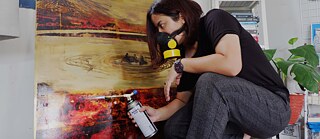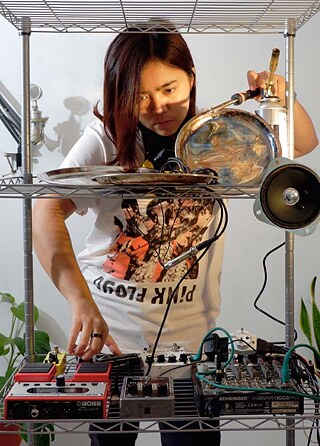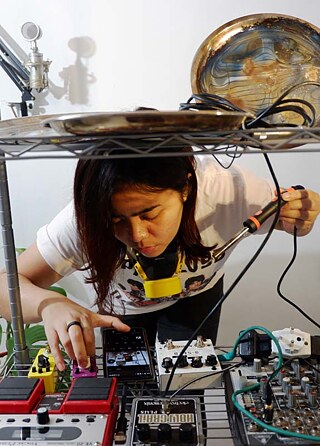Art
Color and Sound in Etza Meisyara’s Performance

Etza Meisyara participated in the Agenda Seniman #AMAN event by sharing her experiences in the study of art and her explorations as well as by giving a performance of sound using a variety of materials and objects. Entitled Intermedia Art Exploration, this edition of #AMAN Agenda Seniman features Bandung-based artist Etza Meisyara (born in 1991) and focuses on the term “intermedia” to describe her artistic journey and interests. What is intermedia art? How did intermedia art become the focus of her work?
Fluxus, Intermedia, and Etza’s Agenda

Etza’s experiments cover a number of genres, from ambient to industrial and noise. What is Etza’s agenda?
Etza shared her thoughts about artistic processes through Goethe-Institut Bandung’s Instagram account. Her interest in the medium of wave energy, in this case sound and color, led her to explore many types of artistic processes. An alumna of the Bandung Institute of Technology majoring in intermedia art, she mentioned Nam June Paik, John Cage, and Yoko Ono—three exponents of the 1960s Fluxus Movement—as her most important sources of inspiration.Founded by George Maciunas, a U.S. American artist of Lithuanian descent, Fluxus was an international movement that popularized the term intermedia art, an idea that utilizes collaboration and interdisciplinary approaches to create innovations and introduce new methods of artistic production. Performance art and video art are two among the many variants that were initiated by the emergence of Fluxus. The movement also attempted to challenge the connection between art and life, and it often even went so far as to cease to distinguish between the two. The impact of Fluxus on the arts and daily life also affected the way Etza selects objects and materials for her creations.
Etza states that her performance for Goethe-Institut’s Agenda Seniman was influenced by a late 1950s John Cage performance titled Water Walk. The performance utilized many everyday objects, including a water-filled bathtub and kitchen utensils. While famously known for his composition 4’33”, Cage’s Water Walk used a number of ways to cause everyday items to emit sounds. In a televised documentary, Cage’s performance triggered a multitude of questions. What kind of performance or composition was this?
In contrast to Cage’s fast-tempoed Water Walk featuring clearly articulated sounds, Etza’s performance moved at a slower pace with overlapping sounds. While Cage emphasized the colors and textures of sounds from various objects and materials, Etza amplified and modulated sounds (with a background of ambient music), thus disguising the sound-emitting objects and materials used in her performance. The audience might have been carried away by Etza’s atmospheric soundscape, but could also have become confused by the noisy onslaught of overlapping sounds.
Etza’s Selection of Materials and Creative Projection

Etza took part in a student exchange program with the Hochschule für Bildende Künste Braunschweig, Germany, before earning her Master’s degree at the Bandung Institute of Technology in 2016 by exploring sounds based on her love of music, which she then turned into performances and installations. She has also participated in a number of residencies in England, Iceland and France among other countries. Experiences gained during her studies, exhibitions and residencies have shaped her creative identity as it is today.
Oxidation and sounds spread in metals. Etza’s performance in Goethe-Institut’s Agenda Seniman offered a spectrum of artistic explorations that combined physical and chemical phenomena with harmonic ideas. She emphasized the dualism between chaos and structure, between dark and light—two opposing conditions necessary to achieve harmony. Etza has probed this theme several times before, one of which was in a performance titled The Rhythm of Tragedy (2019) at the Goethe-Institut Jakarta during the Festival Seni Media Internasional Instrumenta #2: Machine/Magic. Her performance highlighted the idea of the Big Bang event as the starting point of life. Life arises from sound. Sound, a phenomenon of physics, has become one of Etza’s main creative media.
Through Goethe-Institut’s #AMAN Agenda Seniman program series, Etza Meisyara, an artist who hasn’t stopped creating during the COVID-19 pandemic, conveyed her passion for working with various media that spark her artistic spirit. Her performance invited the audience to delve into a series of situations and nuances to achieve enlightenment in the sense of harmony and innovation. Colors and sounds became symbols of the artist’s efforts to respond to the current global situation.